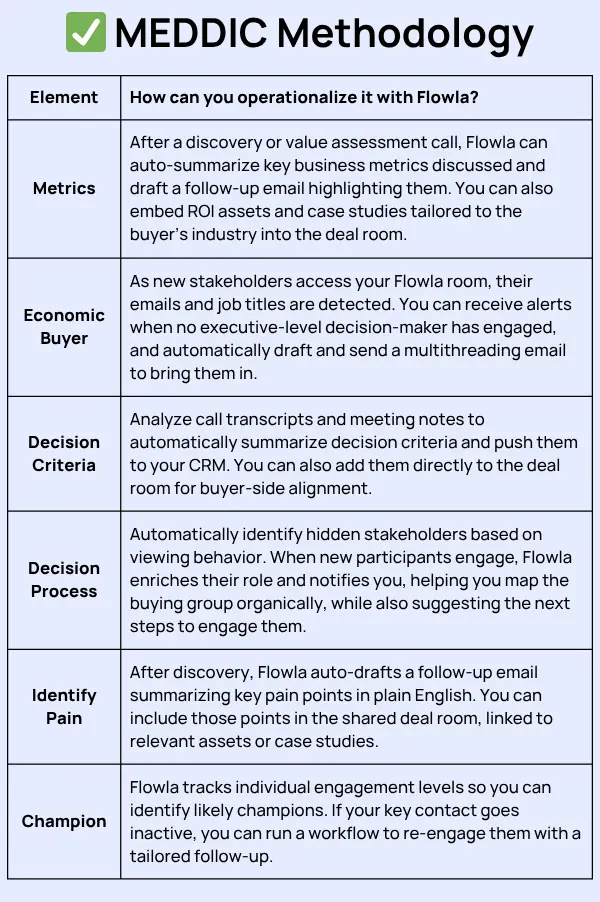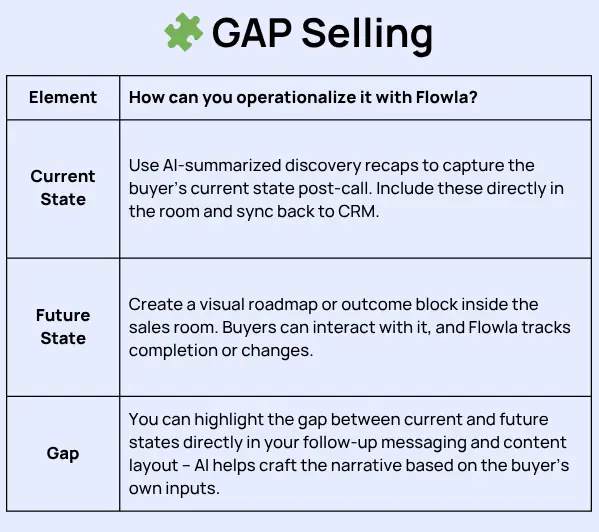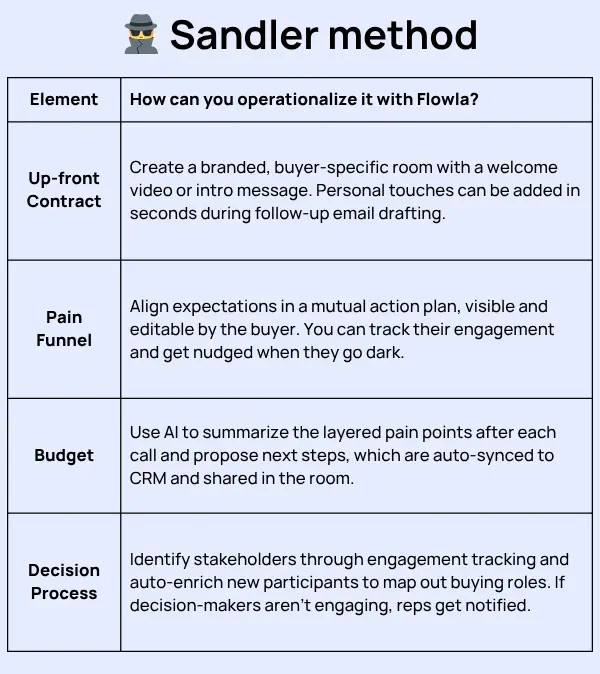From MEDDIC to BANT: How AI Helps Teams Comply with Sales Methodologies

Sales leaders put a lot of time and effort into building out robust methodologies, whether it’s MEDDIC, SPICED, Challenger, or something custom to your org. These frameworks exist for a reason: They’re meant to drive consistency, improve qualification, and help teams close higher-quality deals more predictably.
Yet, in practice, those perfect playbooks often live in a slide deck or Notion doc that gets buried after onboarding.
Reps move fast. They’re juggling multiple deals, switching between tools, and reacting to buyers in real time. Even the most well-designed methodology can fall apart when it’s not easily accessible or when it adds more steps instead of reducing friction.
As a result, playbook adherence becomes something leaders have to chase manually, through pipeline reviews, Slack reminders, or CRM audits. And by the time gaps are spotted, it’s often too late to course-correct.
The real opportunity isn’t just writing better playbooks – it’s finding ways to operationalize them.
But what if your playbook could run automatically in the background? What if the right steps were built into the rep’s workflow – surfaced automatically, tracked, and updated without adding admin burden?
In this post, we’ll break down:
- Why sales methodologies often fall apart in execution
- How workflow automation and AI can bridge the gap between strategy and action
- Practical examples of how key methodology elements (from MEDDIC to SPIN) can be enforced automatically, without slowing your team down
Let’s get into it.
4 reasons why sales methodologies fail in practice
Sales methodologies like MEDDIC, SPICED, Challenger, and others are designed to provide structure and consistency in the sales process. However, in practice, several factors hinder their effective implementation:
1. Reps are overwhelmed and constantly context-switching
Sales representatives often juggle multiple tools and tasks, leading to frequent context switching. According to Asana's 2022 Anatomy of Work Index, workers switch between an average of nine apps daily, with over half feeling compelled to respond to notifications immediately. This constant switching not only hampers productivity but also increases stress and reduces focus.
2. Playbooks are disconnected from live deals
Traditional sales playbooks often reside in static documents or slide decks, making them inaccessible during critical sales interactions. Mary Flaherty, Vice President of Research and Thought Leadership, RAIN Group, highlights that these static playbooks are ineffective in today's dynamic sales environment, emphasizing the need for integrated, real-time guidance.
3. Managers lack real-time visibility
Without integrated systems, sales managers often operate with limited visibility into their team's adherence to sales methodologies. This lack of insight can lead to missed opportunities for timely coaching and intervention. As noted by InsightSquared, poor sales visibility can result in significant revenue losses, with organizations potentially losing up to $15 million annually due to inadequate data utilization.
4. Handoffs and onboarding lose critical methodology steps
Inefficient handoffs between sales and customer success teams can lead to the loss of vital customer information, undermining the continuity of the sales process. A study indicates that poor onboarding and engagement contribute to 52% of customer churn within the first 90 days. Additionally, inconsistent onboarding processes for new sales reps can result in the misapplication or neglect of established sales methodologies.
These challenges highlight the need for integrated, automated solutions that embed sales methodologies into the daily workflows of sales teams, ensuring consistency, visibility, and efficiency throughout the sales process.
Using automation and AI to bridge the methodology execution gap
Most sales teams don’t struggle because their methodology is wrong – they struggle because execution depends too much on memory, manual effort, and perfect timing.
That’s where workflow automation and AI tools come in.
Instead of asking reps to remember the right steps or refer back to a Notion doc, modern tools can embed your sales methodology directly into the rep’s workflow, surfacing guidance at the right time, automating follow-ups, and flagging gaps before they affect deals.
Here’s how automation and AI help turn methodology into consistent action:
1. Embed methodology into everyday workflows
Reps shouldn’t have to jump between tools or documents to follow the process. Automation lets you build your playbook directly into the sales journey, using templates, triggers, and standardized deal rooms.
Example: At a certain stage, reps are prompted to validate the decision-making process or confirm the economic buyer.
This turns the playbook into a system, not a suggestion.
2. Automate nudges, reminders, and triggers
AI and automation can act as a virtual sales coach, flagging when key steps are skipped or overdue, without managers needing to chase manually.
Example: If a deal reaches the proposal stage without documented pain points or clear impact, the system can alert the rep or manager.
3. Capture and sync critical info automatically
Manual CRM updates are prone to gaps. Automation ensures that buyer activity, mutual plans, stakeholder roles, and deal insights are captured as part of the room and synced to the CRM in real time.
Example: When a buyer adds comments or updates a mutual action plan, the system logs those updates without rep intervention.
4. Personalize without starting from scratch
AI can pre-fill or suggest room components based on industry, deal type, persona, or past performance – helping reps stay on-message while still tailoring their approach.
Example: A discovery room for a CFO in SaaS will look different than one for an Ops leader in manufacturing, and reps don’t have to build it from scratch.
5. Make gaps visible so coaching is timely
Instead of waiting until QBRs or post-mortems, AI can highlight in-progress deals where key methodology elements are missing, giving managers a chance to intervene earlier.
Example: A dashboard showing which deals are missing a clear champion or business case.
Next, we’ll look at specific examples of how these automation principles apply to different methodologies – from MEDDIC to SPIN – and what it looks like to bring your playbook to life.
How Flowla ensures sales methodology adherence with smart sales rooms & AI workflows
Most sales teams don’t struggle because their methodology is wrong — they struggle because execution depends too much on memory, manual effort, and perfect timing.
That’s where workflow automation and AI come in.
Instead of asking reps to remember the right steps or dig through disconnected docs, you can use Flowla to embed your methodology directly into day-to-day execution, triggering the right actions at the right time, capturing critical data, and prompting follow-ups before deals go off track.
Here’s how you can put it into practice.
1. Automated workflow triggers based on sales stages
With Flowla, you can set up workflow triggers based on sales stage transitions in your CRM so reps don’t have to build things from scratch or guess what to do next, for example:
- After a discovery or demo call, you can have a workflow to auto-draft a personalized follow-up email and generate a branded deal room that includes relevant content, action plans, and key takeaways – AND send it automatically to the prospect using your email.
- When a deal hits proposal stage, you can have a workflow in Flowla to pull call notes and pricing logic to auto-build a tailored proposal deck, queue it for review, and send it to the buyer, streamlining what’s often a painful manual process.
2. AI-powered content personalization
Flowla helps you act on buyer signals in real time, without needing to dig through activity logs, namely:
- When a new viewer accesses a Flowla room, you can have a workflow to automatically detect their email, enrich their profile to understand their role, and draft a multithreading email for the rep so they can proactively engage hidden stakeholders.
- If an executive viewer spends less than 2 minutes in the room, use Flowla workflow to prompt the champion with internal pitching guidance, helping you manage internal consensus with precision.
3. Real-time monitoring and alerts
You can build engagement rules using Flowla agents that surface at-risk deals before they stall out, for instance:
- If a room has no activity for 7 days, use a workflow to draft a context-aware check-in message, suggest personalized next steps based on deal history, and notify the rep to re-engage.
- When a customer completes all technical validation steps, have Flowla to automatically unlock the onboarding plan and transition the buyer into post-sale mode, without waiting for manual handoff.
4. Seamless CRM integration and data syncing
Flowla keeps your CRM updated automatically so the data stays clean, and your reps stay focused on selling. Here’s how:
- After each call, you can use Flowla’s AI agent to summarize the conversation in plain English, generate next steps, and push them to both Slack and your CRM timeline.
- As buyers interact with the room (viewing proposals, adding comments, completing tasks), set up a workflow in Flowla to sync that activity back to the deal record, keeping your pipeline accurate without added admin work.
5. Enhanced collaboration and handoffs
You can build workflows that ensure no information gets lost between sales and success, including:
- When a deal is marked Closed Won, have Flowla generate a clean internal handoff summary, notify the CSM and Solutions Engineer, and embed onboarding plans into the existing room, keeping everyone aligned.
- For onboarding, you can automatically launch a new room that includes a welcome video, timeline, and AI-generated tasks for both the customer and internal teams.
- You can also create a renewal workflow that kicks in 90 days before the renewal date, pulling in usage data, drafting a QBR deck, and nudging the CSM to start the conversation.
By embedding these automated workflows and AI-driven insights into the sales process, Flowla 2.0 ensures that sales methodologies are not just theoretical frameworks but are actively applied and reinforced throughout the sales cycle.
Now, let’s be more specific and see how this applies to different sales methodologies in real life.






Sales methodology only works if it’s embedded
Sales methodologies are only as effective as their execution.
You can train on MEDDIC, SPICED, or SPIN all day – but if your team has to remember every step, switch between tools, and manually update the CRM, things will fall through the cracks.
Most tools help you document your methodology. Flowla helps you execute it.
By embedding your playbook into automated workflows, triggering the right actions at the right time, and surfacing what’s missing before it costs you the deal, Flowla turns methodology from theory into habit.
- Automate the boring stuff
- Scale what works
- Drive consistent, repeatable execution
Ready to see what that looks like in action? Book a demo and see how your playbook comes to life in Flowla.
Orchestrate your revenue workflows with Flowla
Ensure timely & accurate playbook execution, follow up with clients, sync everything to your CRM and more – automatically.
See in actionRecommended for you
Want to discover Flowla?
Your first 5 rooms are free. No credit cards, no commitments.



.webp)
.webp)
.webp)
.webp)